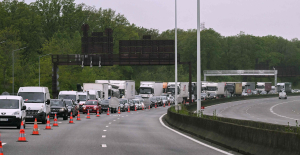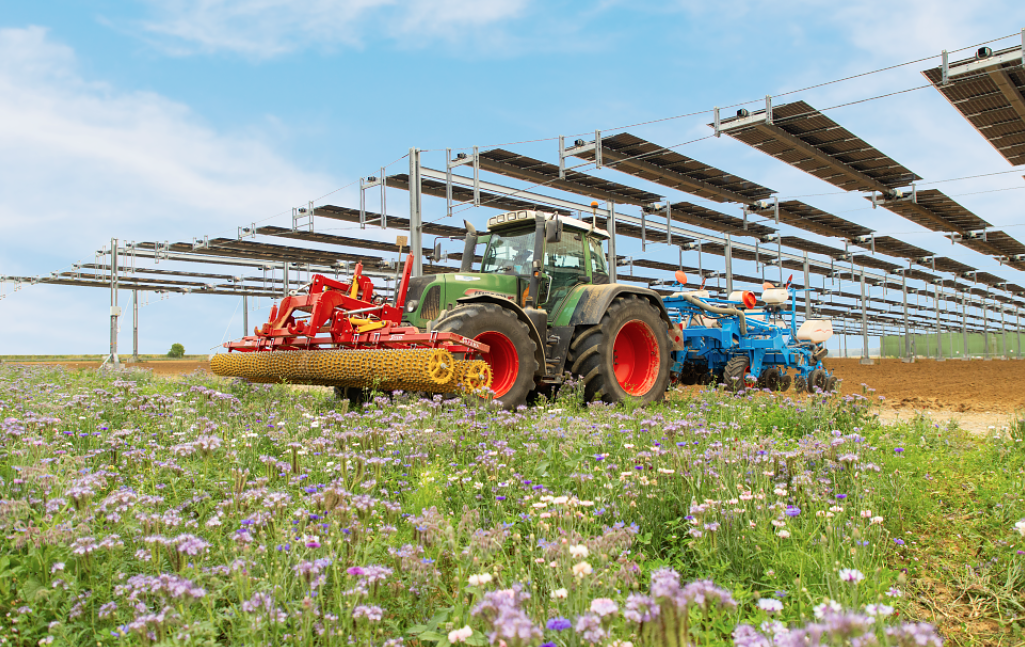A little over a year after the vote on the law to accelerate renewable energies, agrivoltaism finally has its implementing decree, published this Tuesday in the Official Journal. The text was eagerly awaited. The government has announced its publication many times in vain, but this time, it is here!
The decree specifies the principle of non-competition between agricultural activities and energy production established by law. “Let's be clear: it is not a question of replacing agricultural production with solar energy production, but rather of complementing agricultural production with solar energy production. », Specifies Bruno Le Maire, Minister of the Economy, Finance and Industrial and Digital Sovereignty.
Thus, priority is given to agricultural production over energy production. A limit of 40% land coverage rate by agrivoltaic installations is set. In practice, control plots, that is to say having the same characteristics as those on which solar installations are installed, will make it possible to compare yields.
Likewise, a limit of 40% of soil coverage rate by agrivoltaic installations is set, to limit the risks of a drop in yields. In practice, the maintenance of agricultural production will be controlled and measured by different means by the Departmental Territorial Directorates (DDT), including comparison with yields observed on control plots.
The decree specifies in this regard that agricultural yield must be maintained for the entire agrivoltaic installation. In the case of crops for example, production must be at least equal to 90% of that observed in a control plot. This criterion will be subject to specific checks.
“Local stakeholders gathered within the Departmental Commission for the Preservation of Natural and Forest Areas (CDPENAF) will be mobilized to analyze the projects and select the best for agriculture, through an assent to be followed by the services of the State and necessary for any agrivoltaic project,” specifies the government. In the case of crops for example, production must be at least equal to 90% of that observed in a control plot.
Ground-based photovoltaics – without agricultural activity underneath – will only be possible in spaces clearly defined by the chambers of agriculture, through “framework documents”. Uncultivated land, land not exploited for 10 years or more, as well as plots deemed suitable for hosting such projects (industrial wastelands, old quarries, bodies of water, etc.) are concerned. This is to prevent recently cultivated land from being transformed into a photovoltaic field on the ground.
The only downside: with such constraints, nothing says that the acceleration of renewable energies sought by the law will be achieved.

 Austria: incestuous torturer Josef Fritzl, nicknamed the “national monster”, could soon be released
Austria: incestuous torturer Josef Fritzl, nicknamed the “national monster”, could soon be released An airline continues to treat a centenarian as a one-year-old baby
An airline continues to treat a centenarian as a one-year-old baby Germany: the trial of nine “Citizens of the Reich” conspirators begins this Monday
Germany: the trial of nine “Citizens of the Reich” conspirators begins this Monday United Kingdom: David Cameron under fire after renting a jet estimated at 42 million pounds
United Kingdom: David Cameron under fire after renting a jet estimated at 42 million pounds Sánchez cancels his agenda and considers resigning: "I need to stop and reflect"
Sánchez cancels his agenda and considers resigning: "I need to stop and reflect" The Federal Committee of the PSOE interrupts the event to take to the streets with the militants
The Federal Committee of the PSOE interrupts the event to take to the streets with the militants Repsol: "We want to lead generative AI to guarantee its benefits and avoid risks"
Repsol: "We want to lead generative AI to guarantee its benefits and avoid risks" Osteoarthritis: an innovation to improve its management
Osteoarthritis: an innovation to improve its management Closure of the A13: would it really be possible to make the A14 free?
Closure of the A13: would it really be possible to make the A14 free? Surprise retirement of HSBC chief executive Noel Quinn
Surprise retirement of HSBC chief executive Noel Quinn Fight against disinformation: Brussels puts pressure on Facebook and Instagram as the European elections approach
Fight against disinformation: Brussels puts pressure on Facebook and Instagram as the European elections approach McDonald's results still suffer from boycott linked to the war in Gaza
McDonald's results still suffer from boycott linked to the war in Gaza The Musée du Grand Siècle in Saint-Cloud, this 100 million euro project in Hauts-de-Seine which would weaken the A13
The Musée du Grand Siècle in Saint-Cloud, this 100 million euro project in Hauts-de-Seine which would weaken the A13 Marjane Satrapi distinguished by the Princess of Asturias Foundation
Marjane Satrapi distinguished by the Princess of Asturias Foundation Royal Enfield Shotgun, 'custom' attitude from Monday to Sunday
Royal Enfield Shotgun, 'custom' attitude from Monday to Sunday End of the legal battle between Britney Spears and her father
End of the legal battle between Britney Spears and her father Omoda 7, another Chinese car that could be manufactured in Spain
Omoda 7, another Chinese car that could be manufactured in Spain BYD chooses CA Auto Bank as financial partner in Spain
BYD chooses CA Auto Bank as financial partner in Spain Tesla and Baidu sign key agreement to boost development of autonomous driving
Tesla and Baidu sign key agreement to boost development of autonomous driving Skoda Kodiaq 2024: a 'beast' plug-in hybrid SUV
Skoda Kodiaq 2024: a 'beast' plug-in hybrid SUV The home mortgage firm rises 3.8% in February and the average interest moderates to 3.33%
The home mortgage firm rises 3.8% in February and the average interest moderates to 3.33% This is how housing prices have changed in Spain in the last decade
This is how housing prices have changed in Spain in the last decade The home mortgage firm drops 10% in January and interest soars to 3.46%
The home mortgage firm drops 10% in January and interest soars to 3.46% The jewel of the Rocío de Nagüeles urbanization: a dream villa in Marbella
The jewel of the Rocío de Nagüeles urbanization: a dream villa in Marbella Europeans: a senior official on the National Rally list
Europeans: a senior official on the National Rally list Blockade of Sciences Po: the right denounces a “drift”, the government charges the rebels
Blockade of Sciences Po: the right denounces a “drift”, the government charges the rebels Even on a mission for NATO, the Charles-de-Gaulle remains under French control, Lecornu responds to Mélenchon
Even on a mission for NATO, the Charles-de-Gaulle remains under French control, Lecornu responds to Mélenchon “Deadly Europe”, “economic decline”, immigration… What to remember from Emmanuel Macron’s speech at the Sorbonne
“Deadly Europe”, “economic decline”, immigration… What to remember from Emmanuel Macron’s speech at the Sorbonne These French cities that will boycott the World Cup in Qatar
These French cities that will boycott the World Cup in Qatar Premier League: Manchester United ready to sell the vast majority of its workforce
Premier League: Manchester United ready to sell the vast majority of its workforce Paris 2024 Olympics: when will Thierry Henry reveal the list of Olympic Blues?
Paris 2024 Olympics: when will Thierry Henry reveal the list of Olympic Blues? Rugby: Qatar's astronomical offer to host the biggest clashes between North and South
Rugby: Qatar's astronomical offer to host the biggest clashes between North and South OM-Atalanta Bergamo: at what time and on which channel to watch the Europa League semi-final first leg?
OM-Atalanta Bergamo: at what time and on which channel to watch the Europa League semi-final first leg?

















